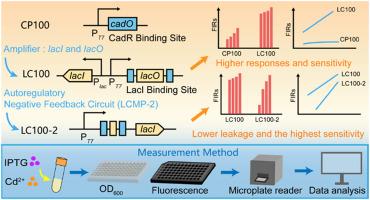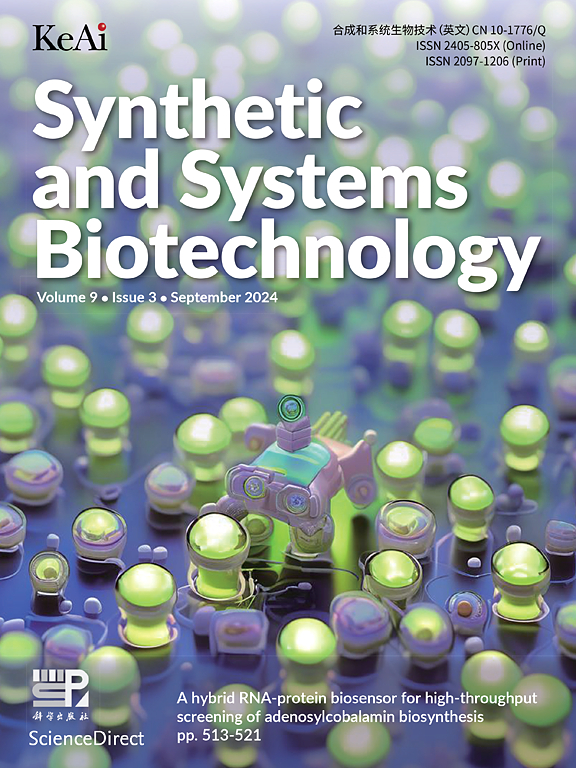具有基于合成双输入启动子的调节电路的全细胞生物传感器,能够高度灵敏地检测超痕量Cd2+
IF 4.4
2区 生物学
Q1 BIOTECHNOLOGY & APPLIED MICROBIOLOGY
引用次数: 0
摘要
针对痕量和超痕量检测的全细胞生物传感器的研究仍然有限,基于天然细菌重金属抗性机制的生物传感器普遍存在灵敏度低的问题。本研究首先利用镉离子(Cd2+)结合蛋白结合位点cadO与T7启动子设计了启动子PT7-cadO,构建了单输入全细胞生物传感器CP100,该传感器对Cd2+的检出限符合WHO要求,但其响应和灵敏度较低。我们进一步引入lacI和lac算子(lacO)作为信号放大器,构建双输入启动子PT7-cadO-lacO-cadO,并开发了LC100生物传感器,其响应和灵敏度得到了显著提高,但背景泄漏成为新的问题。然后基于结构为“CadR-PJ23100-PT7-cadO-lacO-cadO-mRFP1-LacI”的调控电路LCPM-2重新设计基因电路,以LacI蛋白为自调控负反馈模型,最终获得命名为LC100-2的生物传感器,实现了超微量Cd2+ (0.00001-0.02 nM)的检测,灵敏度为CP100的3748.22倍。LC100-2对其他四种二价金属离子中的Cd2+具有良好的特异性,在混合二价金属离子体系中具有良好的抗干扰能力。实际水样测试结果表明,只需加入少量样品(1 μL),就可以实现对Cd2+的精确定量检测,最终浓度为0.001 ~ 0.02 nM。这一发现在痕量检测领域具有广阔的应用前景。此外,基于独特双输入启动子的调控电路LCPM-2增强了响应,同时减少了背景泄漏,从而为生物传感器电路的设计和简化提供了一种创新策略。本文章由计算机程序翻译,如有差异,请以英文原文为准。

Whole-cell biosensors with regulatory circuits based on a synthetic dual-input promoter enabling the highly sensitive detection of ultra-trace Cd2+
The research on whole-cell biosensors tailored for trace and ultra-trace detection remains limited and the biosensors based on natural bacterial heavy metal resistance mechanisms have common issues of low sensitivity. In this study, we designed a promoter PT7-cadO using the Cadmium ions (Cd2+)-binding protein binding site cadO with the T7 promoter at first and constructed a single-input whole-cell biosensor, which was named CP100, whose detection limit for Cd2+ met the WHO requirement, yet its response and sensitivity were quite low. We further introduced the lacI and lac operator (lacO) as the signal amplifier to construct a dual-input promoter PT7-cadO-lacO-cadO and developed a biosensor named LC100, whose response and sensitivity were significantly improved, but background leakage became a new problem. Then we redesigned the gene circuit based on the regulatory circuit LCPM-2, which has the structure of “CadR-PJ23100-PT7-cadO-lacO-cadO-mRFP1-LacI”, with the LacI protein as the autoregulatory negative feedback model and finally obtained the biosensor named LC100-2, which achieved the detection of ultra-trace Cd2+ (0.00001–0.02 nM), with the sensitivity of 3748.22 times that of CP100. Moreover, LC100-2 demonstrated excellent specificity to Cd2+ among four other divalent metal ions and good anti-interference capability in the mixed divalent metal ions system. The results of the real water sample tests demonstrated that precise quantitative detection of Cd2+ with a final concentration of 0.001–0.02 nM could be achieved by adding only a small volume of the sample (1 μL). This finding showed promising application potential in the field of trace detection. Additionally, the regulatory circuit LCPM-2 based on the unique dual-input promoter enhanced responses and reduced background leakage simultaneously, thereby providing an innovative strategy for the design and simplification of biosensors’ circuits.
求助全文
通过发布文献求助,成功后即可免费获取论文全文。
去求助
来源期刊

Synthetic and Systems Biotechnology
BIOTECHNOLOGY & APPLIED MICROBIOLOGY-
CiteScore
6.90
自引率
12.50%
发文量
90
审稿时长
67 days
期刊介绍:
Synthetic and Systems Biotechnology aims to promote the communication of original research in synthetic and systems biology, with strong emphasis on applications towards biotechnology. This journal is a quarterly peer-reviewed journal led by Editor-in-Chief Lixin Zhang. The journal publishes high-quality research; focusing on integrative approaches to enable the understanding and design of biological systems, and research to develop the application of systems and synthetic biology to natural systems. This journal will publish Articles, Short notes, Methods, Mini Reviews, Commentary and Conference reviews.
 求助内容:
求助内容: 应助结果提醒方式:
应助结果提醒方式:


